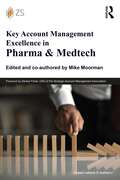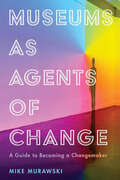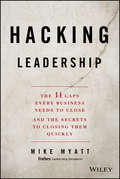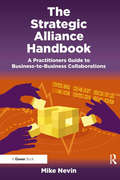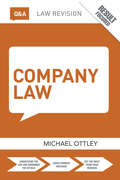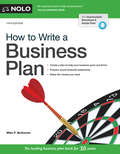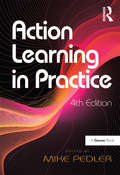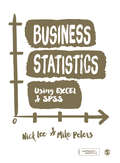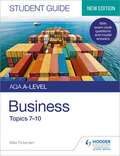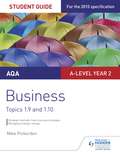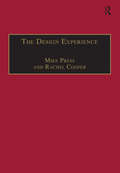- Table View
- List View
Key Account Management Excellence in Pharma & Medtech
by Mike MoormanKey Account Management Excellence in Pharma & Medtech is designed to help life sciences practitioners develop and execute innovative and effective key account management (KAM) strategies and capabilities. Pharmaceutical and medtech companies are increasingly pursuing KAM in response to the rapid rise of large, sophisticated and complex healthcare provider and payer systems and groups. Those that invest the time to get KAM right will protect their business and grow with these rising customers. This book is groundbreaking in both its scope and its tailoring of leading KAM practices specifically for life sciences. The central theme is that "key account management is an organization-wide business strategy, not just a role or a sales-specific initiative." KAM is a strategy focused on providing unique offerings and value through an orchestrated, cross-functional, go-to-market model designed specifically to address the needs and engagement preferences of a unique segment of customers. The insights and practices shared in this book are designed to be a valuable reference at every stage of the KAM journey. The book has been designed to facilitate a common language and deep understanding of KAM issues and leading practices organization-wide—particularly for life sciences leaders, account managers and cross-functional team members responsible for building, transforming and supporting their organization’s KAM strategies and capabilities.
Brand Icons: How to Build a Unique Brand
by Mike MoserIdentifying and clarifying your brand icons-defined as anything that is unique to your brand and that brings up an image of your brand in the customer's mind-is an important step in creating a brand roadmap. This chapter will help you determine which brand icons will work best for your brand.
Brand Personality: How to Build a Unique Brand
by Mike MoserA well-defined brand personality can create an immediate point of differentiation in the marketplace. This chapter will show you how to determine the personality your brand is going to use to communicate its core values and core message.
Core Brand Message: How to Build a Unique Brand
by Mike MoserThe core brand message is the key message that your company will be communicating to all its audiences. All other messages coming from the company will be offshoots of this message. This chapter will take you through a process that will ensure that the brand message you come up with will work in the marketplace for years to come.
Core Brand Values: How to Build a Unique Brand
by Mike MoserThis chapter will help you articulate your company's core brand values, which make up the foundation for every decision your company makes-from the kind of people you hire, to the kinds of customers you pursue, to the marketing decisions you make. A worksheet to guide you through the process is included.
You're Five Steps Away from Having a Customized Brand
by Mike MoserA split often occurs between a company's internal and an external identity. When the internal and external identities are consistent, the brand is strong, but when these identities are at odds, the brand is weak. This chapter describes the imperative of creating a brand roadmap in order to build a cohesive identity both inside and outside your company.
Your Brand Roadmap: How to Build a Unique Brand
by Mike MoserThis chapter shows you how to create a brand roadmap-a practical, day-to-day guide for your brand that articulates your core brand values, core message, and brand personality. This exercise will help you see the consistencies and inconsistencies in your brand and ensure that your brand will be seen, heard, and remembered in the marketplace for years to come.
Museums as Agents of Change: A Guide to Becoming a Changemaker
by Mike MurawskiMuseums everywhere have the potential to serve as agents of change—bringing people together, contributing to local communities, and changing people’s lives. So how can we, as individuals, radically expand the work of museums to live up to this potential? How can we more fiercely recognize the meaningful work that museums are doing to enact change around the relevant issues in our communities? How can we work together to build a stronger culture of equity and care within museums ? Questions like these are increasingly vital for all museum professionals to consider, no matter what your role is within your institution. They are also important questions for all of us to be thinking about more deeply as citizens and community members. This book is about the work we need to do to become changemakers and demand that that our museums take action toward positive social change and bring people together into a more just, equitable, compassionate, and connected society. It is a journey toward tapping the energies within all of us to make change happen and proactively shape a new future.
Hacking Leadership
by Mike MyattHacking Leadership is Mike Myatt's latest leadership book written for leaders at every level. Leadership isn't broken, but how it's currently being practiced certainly is. Everyone has blind spots. The purpose of Hacking Leadership is to equip leaders at every level with an actionable framework to identify blind spots and close leadership gaps. The bulk of the book is based on actionable, topical leadership and management hacks to bridge eleven gaps every business needs to cross in order to create a culture of leadership: leadership, purpose, future, mediocrity, culture, talent, knowledge, innovation, expectation, complexity, and failure. Each chapter: Gives readers specific techniques to identify, understand, and most importantly, implement individual, team and organizational leadership hacks.Addresses blind spots and leverage points most leaders and managers haven't thought about, which left unaddressed, will adversely impact growth, development, and performance. All leaders have blind-spots (gaps), which often go undetected for years or decades, and sadly, even when identified the methods for dealing with them are outdated and ineffective - they need to be hacked.Showcases case studies from the author's consulting practice, serving as a confidant with more than 150 public company CEOs. Some of those corporate clients include: AT&T, Bank of America, Deloitte, EMC, Humana, IBM, JP Morgan Chase, Merrill Lynch, PepsiCo, and other leading global brands. Hacking Leadership offers a fresh perspective that makes it easy for leaders to create a roadmap to identify, refine, develop, and achieve their leadership potential--and to create a more effective business that is financially solvent and professionally desirable.
Stop Clutter from Stealing Your Life: Discover Why You Clutter and How You Can Stop
by Mike NelsonAccording to the author, a recovering clutterer, this problem is not just a minor annoyance or an organizational challenge: it can destroy self-esteem and relationships, contribute to financial problems, and even lead to unemployment. His new guide deals with why people clutter and offers effective ways to deal with this problem. He then give practical steps anyone can take to stay clutter-free.
The Strategic Alliance Handbook: A Practitioners Guide to Business-to-Business Collaborations
by Mike NevinStrategic alliances offer organisations an alternative to organic growth or acquisition when faced with the need to develop the business to a new level, innovate in terms of products or services or significantly reduce costs. The Strategic Alliance Handbook is a clear and complete guide to the nuts and bolts of the process behind successful collaborations. The book enables readers to understand the commercial, technical, strategic, cultural and operational logic behind any alliance and to establish an approach that is appropriate for the type of alliance they are seeking and the partner organisation(s) with whom they are working. Whether you are an alliance executive, responsible for the systems, strategy and performance of your organisation's alliancing programme or an alliance manager needing to ensure the success of a given partnership, The Strategic Alliance Handbook is an essential guide.
Q&A Company Law (Questions and Answers)
by Mike OttleyRoutledge Q&As give you the tools to practice and refine your exam technique, showing you how to apply your knowledge to maximum effect in assessment. Each book contains essay and problem-based questions on the most commonly examined topics, complete with expert guidance and model answers that help you to: Plan your revision and know what examiners are looking for: Introducing how best to approach revision in each subject Identifying and explaining the main elements of each question, and providing marker annotation to show how examiners will read your answer Understand and remember the law: Using memorable diagram overviews for each answer to demonstrate how the law fits together and how best to structure your answer Gain marks and understand areas of debate Providing revision tips and advice to help you aim higher in essays and exams Highlighting areas that are contentious and on which you will need to form an opinion Avoid common errors: Identifying common pitfalls students encounter in class and in assessment The series is supported by an online resource that allows you to test your progress during the run-up to exams. Features include: multiple choice questions, bonus Q&As and podcasts.
How to Write a Business Plan
by Mike P. McKeeverStep-by-step advice on preparing a business plan You need a sound business plan to start a business or raise money to expand an existing one. For over 30 years, How to Write a Business Plan has helped fledgling entrepreneurs—from small service businesses and retailers to large manufacturing firms—write winning plans and get needed financing. This bestselling book contains clear step-by-step instructions and forms to put together a convincing business plan with realistic financial projections, effective marketing strategies, and overall business goals. You’ll learn how to: figure out if your business idea will make money determine and forecast cash flow create profit and loss forecasts prepare marketing and personnel plans find potential sources of financing, and present your well-organized plan to lenders and other backers. This edition is updated to reflect best practices for raising money (from SBA loans to equity crowdfunding).
The Day It Finally Happens: Alien Contact, Dinosaur Parks, Immortal Humans - And Other Possible Phenomena
by Mike Pearl__________If you live on planet Earth, you're probably scared about the future.Terrorism, complicated international relations, global warming, killer viruses and a raft of other issues make it hard not to be.Watching the news you have to wonder: is it safe to go out there or not?In The Day It Finally Happens, Mike Pearl games out many of the 'could it really happen?' scenarios we've all speculated about, assigning a probability rating, and taking us through how it would unfold. He explores what would likely occur in dozens of possible scenarios - the final failure of antibiotics, the loss of the world's marine life, the abolition of the British monarchy, and even the arrival of aliens - and reports back from the future, providing a clear picture on how the world would look, feel, and even smell in each of these instances.Hilarious, enlightening, and terrifying, this book makes science accessible and is a unique form of existential therapy, offering practical answers to some of our most worrisome questions.Thankfully, the odds of humanity pulling through look pretty good.__________For fans of such bestsellers as What If?,The Worst Case Scenario Survival Handbook and The Uninhabitable Earth, as well as Steven Pinker and Malcolm Gladwell, this is a book about future events that we don't really understand and getting to know them in close detail.Entertaining speculation featuring both authoritative research and a bit of mischief: a look at how humanity is likely to weather such happenings as the day nuclear war occurs, the day the global internet goes down, the day we run out of effective antibiotics, and the day immortality is achieved.
The Day It Finally Happens: Alien Contact, Dinosaur Parks, Immortal Humans - And Other Possible Phenomena
by Mike Pearl__________If you live on planet Earth, you're probably scared about the future. Terrorism, complicated international relations, global warming, and a raft of other issues make it hard not to be. Watching the news you have to wonder: is it safe to go out there or not? In The Day It Finally Happens, Mike Pearl games out many of the 'could it really happen?' scenarios we've all speculated about, assigning a probability rating, and taking us through how it would unfold. He explores what would likely occur in dozens of possible scenarios - the final failure of antibiotics, the loss of the world's marine life, the abolition of the British monarchy, and even the arrival of aliens - and reports back from the future, providing a clear picture on how the world would look, feel, and even smell in each of these instances. Hilarious, enlightening, and terrifying, this book makes science accessible and is a unique form of existential therapy, offering practical answers to some of our most worrisome questions. Thankfully, the odds of humanity pulling through look pretty good. __________For fans of such bestsellers as What If?,The Worst Case Scenario Survival Handbook and The Uninhabitable Earth, as well as Steven Pinker and Malcolm Gladwell, this is a book about future events that we don't really understand and getting to know them in close detail. Entertaining speculation featuring both authoritative research and a bit of mischief: a look at how humanity is likely to weather such happenings as the day nuclear war occurs, the day the global internet goes down, the day we run out of effective antibiotics, and the day immortality is achieved.(P) 2019 Simon & Schuster Audio
Action Learning in Practice
by Mike PedlerPrevious editions of Action Learning in Practice established this authoritative overview of action learning around the world. Over the last decade the move towards action-based organizational learning and development has accelerated, and action learning is now an established part of the education and development mainstream in large and small organizations. Fully revised and updated, this fourth edition covers the origins of action learning with Reg Revans' ideas, and looks at their development and application today. Action learning is self-directed learning through tackling business and work problems with the support of peers and colleagues. A professional and diverse workforce, attracted, influenced and developed in this way is more able to deal effectively with the growing complexity and pressures of working life. As the limits of conventional training and development become more obvious, leaders are increasingly attracted to action-based approaches to learning when seeking better outcomes and returns on investment.
Business Statistics Using EXCEL and SPSS
by Nick Lee Mike Peters'Takes the challenging and makes it understandable. The book contains useful advice on the application of statistics to a variety of contexts and shows how statistics can be used by managers in their work.' - Dr Terri Byers, Assistant Professor, University Of New Brunswick, Canada A book about introductory quantitative analysis, the authors show both how and why quantitative analysis is useful in the context of business and management studies, encouraging readers to not only memorise the content but to apply learning to typical problems. Fully up-to-date with comprehensive coverage of IBM SPSS and Microsoft Excel software, the tailored examples illustrate how the programmes can be used, and include step-by-step figures and tables throughout. A range of ‘real world’ and fictional examples, including "The Ballad of Eddie the Easily Distracted" and "Esha's Story" help bring the study of statistics alive. A number of in-text boxouts can be found throughout the book aimed at readers at varying levels of study and understanding Back to Basics for those struggling to understand, explain concepts in the most basic way possible - often relating to interesting or humorous examples Above and Beyond for those racing ahead and who want to be introduced to more interesting or advanced concepts that are a little bit outside of what they may need to know Think it over get students to stop, engage and reflect upon the different connections between topics A range of online resources including a set of data files and templates for the reader following in-text examples, downloadable worksheets and instructor materials, answers to in-text exercises and video content compliment the book. An ideal resource for undergraduates taking introductory statistics for business, or for anyone daunted by the prospect of tackling quantitative analysis for the first time.
Business Statistics Using EXCEL and SPSS
by Nick Lee Mike Peters'Takes the challenging and makes it understandable. The book contains useful advice on the application of statistics to a variety of contexts and shows how statistics can be used by managers in their work.' - Dr Terri Byers, Assistant Professor, University Of New Brunswick, Canada A book about introductory quantitative analysis, the authors show both how and why quantitative analysis is useful in the context of business and management studies, encouraging readers to not only memorise the content but to apply learning to typical problems. Fully up-to-date with comprehensive coverage of IBM SPSS and Microsoft Excel software, the tailored examples illustrate how the programmes can be used, and include step-by-step figures and tables throughout. A range of 'real world' and fictional examples, including "The Ballad of Eddie the Easily Distracted" and "Esha's Story" help bring the study of statistics alive. A number of in-text boxouts can be found throughout the book aimed at readers at varying levels of study and understanding Back to Basics for those struggling to understand, explain concepts in the most basic way possible - often relating to interesting or humorous examples Above and Beyond for those racing ahead and who want to be introduced to more interesting or advanced concepts that are a little bit outside of what they may need to know Think it over get students to stop, engage and reflect upon the different connections between topics A range of online resources including a set of data files and templates for the reader following in-text examples, downloadable worksheets and instructor materials, answers to in-text exercises and video content compliment the book. An ideal resource for undergraduates taking introductory statistics for business, or for anyone daunted by the prospect of tackling quantitative analysis for the first time.
Innovation in Hospitality and Tourism
by Mike PetersGet the latest research on new ways to measure innovation in the tourism value chainUntil now, most available research on innovation in tourism product service and development has focused on concepts, rather than facts. Innovation in Hospitality and Tourism presents empirical studies that identify the major "push and pull" factors of innovation in hospitality and tourism, providing vital information on how to measure innovation in the control and sustainable management of new service development. This unique book examines the internal and external drivers of innovation in the market place, the difference between innovative firms and those that merely follow trends, and explanations and examples of innovations in special areas of the tourism value chain.With hospitality markets saturated and clients selecting services from all over the world, it&’s not enough to have an innovative idea for a new tourism product-your idea has to have the potential to be successfully marketed. Innovation in Hospitality and Tourism looks at methods of measuring the market-based applications of new processes, products, and forms of organization, the economic impact of innovation, innovation as a bipolar process between market and resources, and forms of cooperation that can strengthen and reinforce innovation. The book&’s contributors analyze the relationship between welfare services and tourism in Denmark, the innovation potential throughout the tourism value chain from the supply side focus, innovation as a competitive advantage in Alpine tourism and in the small- and medium-sized hotel industry, tourism innovation statistics across products, providers, markets, and geopolitical regions, and a case study of AltiraSPA, a wellness concept of the ArabellaSheraton group.Innovation in Hospitality and Tourism examines: product development measuring innovation consumer-based measurement of innovation innovation processes in hotel chains innovation performances in hotel chains and independent hotels mobile business solutions for tourist destinations Internet portals in tourism analyzing innovation potential leadership and innovation processes welfare services and tourism as a driving force for innovation SERVQUAL as a tool for developing innovations and much moreInnovation in Hospitality and Tourism is an invaluable resource for academics, professionals, practitioners, and researchers working in the field of hospitality and tourism.
Lenguaje corporal: Secretos del lenguaje corporal femenino
by Mike PhippsLenguaje corporal: Secretos del lenguaje corporal femenino por Mike Phipps ¿Estás listo para dejar de andar por las ramas y averiguar si le gustas? El lenguaje corporal: los secretos del lenguaje corporal femenino (16B) Si quieres saber cómo leer las señales que te está dando y averiguar si te está mirando como algo más que un encuentro casual, entonces has venido al lugar correcto. Este libro te dirá todas esas pequeñas señales que ella emite. Un hecho que debe saber es que el 7% de cualquier mensaje se transmite a través de palabras, el 38% a través del tono de voz y el 55% a través de señales no verbales. Más de la mitad de la comunicación cara a cara no es verbal. Usted podría estar teniendo una conversación increíble con una mujer toda la noche y pensar que todo va de maravilla. Pero si no puedes captar sus señales no verbales, en el mejor de los casos sólo podrás adivinar si ella te quiere - puedes tirar una moneda al aire.
AQA A-level Business Student Guide 2: Topics 7–10
by Mike PickerdenReinforce your understanding of managers, leadership and decision-making with this AQA A-level Business Student Guide. This book covers Themes 1-7 of the 10 themes in A-level Business, which can be examined in all three A-level papers: -Analysing the strategic position of a business-Choosing strategic direction-Strategic methods: how to pursue strategies-Managing strategic changeThis Student Guide will help you to:-Identify key content for the exams with our concise coverage of topics-Avoid common pitfalls with clear definitions and exam tips throughout-Reinforce your learning with bullet-list summaries at the end of each section-Test your knowledge with rapid-fire knowledge check questions and answers-Find out what examiners are looking for with our Questions & Answers section
AQA A-level Business Student Guide 2: Topics 7–10
by Mike PickerdenReinforce your understanding of managers, leadership and decision-making with this AQA A-level Business Student Guide. This book covers Themes 1-7 of the 10 themes in A-level Business, which can be examined in all three A-level papers: -Analysing the strategic position of a business-Choosing strategic direction-Strategic methods: how to pursue strategies-Managing strategic changeThis Student Guide will help you to:-Identify key content for the exams with our concise coverage of topics-Avoid common pitfalls with clear definitions and exam tips throughout-Reinforce your learning with bullet-list summaries at the end of each section-Test your knowledge with rapid-fire knowledge check questions and answers-Find out what examiners are looking for with our Questions & Answers section
AQA A-level Business Student Guide 4: Topics 1.9-1.10
by Mike PickerdenExam Board: AQALevel: A-levelSubject: BusinessFirst Teaching: September 2015First Exam: September 2017Written by examiners and teachers, Student Guides:- Help students identify what they need to know with a concise summary of the theme examined in the A-level specification- Consolidate understanding with exam tips and knowledge check questions- Provide opportunities to improve exam technique with sample graded answers to exam-style questions- Develop independent learning and research skills - Provide the content for generating individual revision notes
The Design Experience: The Role of Design and Designers in the Twenty-First Century
by Rachel Cooper Mike PressHow are we to understand the changing role of design and designers in the new age of consumer experience? Drawing on perspectives from cultural studies, design management, marketing, new product development and communications theory, The Design Experience explores the contexts, practices and roles of designers in today's world, providing an accessible introduction to the key issues reshaping design. The book begins by analysing how consumers acquire meaning and identity from product and other experiences made possible by design. It then explores issues of competitiveness, innovation and management in the context of industry and commerce. If designers are creators of human experiences, what does this mean for their future role in culture and commerce? Subsequent chapters look at new ways in which designers conduct user research and how designers should communicate about design and decision-making with key stakeholders. The authors conclude with a discussion of the design 'profession': will that label be a help or hindrance for tomorrow's designer? Written for students of design, design management, cultural and business studies, The Design Experience is also of interest to practitioners of design, marketing and management. Illustrated case study material is integrated into the text, and the book also includes a glossary, and extensive references.
Rugby Union and Professionalisation: Elite Player Perspectives (Routledge Research in Sport, Culture and Society)
by Mike RaynerThe game of rugby has changed significantly in the course of its history. In the early part of the 19th century it evolved from a folk game played by the working class to a recreational activity for public schoolboys. From the 1820s rugby represented an opportunity for gentlemen to demonstrate physical prowess and masculinity and in more recent times it has developed into an activity that reflects the changing attitudes towards professional sport. For the most part of the last one hundred years, rugby union became an important international sport that represented the nationalistic ideals of a number of countries. However, a number of developments, including the increasing influence of a business ethos within sport during the latter decades of the twentieth century, exposed rugby union to the realities of commercialism and all the factors associated with it, especially the demands of a more diverse spectating public. Drawing on interview material with forty-eight elite level rugby union players from England, Wales, Scotland, France, Ireland, South Africa, New Zealand and Australia who participated in elite level rugby union either before, in the overlapping period or after the declaration of professionalism, this book traces the evolution of attitudes towards professionalism from a players’ perspective and develops a critical review of the impact that professionalism has had upon the sport of rugby union. Rugby Union and Professionalisation: Elite Player Perspectives is fascinating reading for all students and scholars with an interest in rugby union, sport history, sport policy, sport management and the sociology of sport.
